Assessment of Integrated BMPs for Subbasin-Scale Soil Erosion Reduction Considering Spatially Distributed Farmland Characteristics
Abstract
1. Introduction
2. Methods
2.1. Description of the Study Watershed
2.2. Model Description of SWAT and MUSLE
2.3. Application of SD-HRU and Modified MUSLE for Soil Erosion Management in SWAT
2.4. SWAT Input Data Collection
2.5. Evaluation of SWAT Performance Through Calibration and Validation
2.6. Integrated BMP Strategies for Soil Erosion Control and SS Load Reduction
3. Results and Discussion
3.1. Calibration and Validation Results of MUSLE and SWAT for SS Load Simulation
3.2. Effectiveness of BMPs in Soil Erosion Reduction
3.3. Scenario-Based Assessment of SS Load and Soil Erosion Reduction
3.4. Soil Erosion Reduction and Subbasin Prioritization for Sustainable Watershed Management
4. Conclusions
Author Contributions
Funding
Institutional Review Board Statement
Data Availability Statement
Conflicts of Interest
References
- Jin, G.; Li, Z.; Deng, X.; Yang, J.; Chen, D.; Li, W. An analysis of spatiotemporal patterns in Chinese agricultural productivity between 2004 and 2014. Ecol. Indic. 2019, 105, 591–600. [Google Scholar] [CrossRef]
- Wang, Y.; Bian, J.; Zhao, Y.; Tang, J.; Jia, Z. Assessment of future climate change impacts on nonpoint source pollution in snowmelt period for a cold area using SWAT. Sci. Rep. 2018, 8, 2402. [Google Scholar] [CrossRef] [PubMed]
- Zeiger, S.J.; Owen, M.R.; Pavlowsky, R.T. Simulating nonpoint source pollutant loading in a karst basin: A SWAT modeling application. Sci. Total Environ. 2021, 785, 147295. [Google Scholar] [CrossRef]
- Wang, Y.; Wu, C.; Zhao, Z.; Yu, B.; Liu, G. Assessing spatiotemporal heterogeneity of coastal organic nonpoint source pollution via soil erosion in Yellow River Delta, China. Ecol. Indic. 2024, 166, 112519. [Google Scholar] [CrossRef]
- Harano, F.K.F.; Galvanin, E.A.S. Spatio-temporal assessment of potential nonpoint pollution risk sources in the Chavantes reservoir basin, Brazil. J. S. Am. Earth Sci. 2025, 152, 105310. [Google Scholar] [CrossRef]
- Zheng, Y.; Han, F.; Tian, Y.; Wu, B.; Lin, Z. Chapter 5—Addressing the uncertainty in modeling watershed nonpoint source pollution. In Ecological Modeling and Engineering of Lakes and Wetlands; Elsevier: Amsterdam, The Netherlands, 2014; Volume 26, pp. 113–159. [Google Scholar]
- Zuo, D.; Bi, Y.; Song, Y.; Xu, Z.; Wang, G.; Ma, G.; Abbaspour, K.C.; Yang, H. The response of nonpoint source pollution to land use change and risk assessment based on model simulation and grey water footprint theory in an agricultural river basin of Yangtze river, China. Ecol. Indic. 2023, 154, 110581. [Google Scholar] [CrossRef]
- Zhang, T.; Yang, Y.; Ni, J.; Xie, D. Adoption behavior of cleaner production techniques to control agricultural nonpoint source pollution: A case study in the Three Gorges Reservoir Area. J. Clean. Prod. 2019, 223, 897–906. [Google Scholar] [CrossRef]
- Zou, L.L.; Liu, Y.S.; Wang, Y.S.; Hu, X.D. Assessment and analysis of agricultural nonpoint source pollution loads in China: 1978–2017. J. Environ. Manag. 2020, 263, 110400. [Google Scholar] [CrossRef]
- Hussain, F.; Ahmed, S.; Naqvi, S.M.Z.A.; Awais, M.; Zhang, Y.; Zhang, H.; Raghavan, V.; Zhang, Y.; Zhao, G.; Hu, J. Agricultural Non-Point Source Pollution: Comprehensive Analysis of Sources and Assessment Methods. Agriculture 2025, 15, 531. [Google Scholar] [CrossRef]
- Nuruzzaman, M.; Bahar, M.M.; Naidu, R. Diffuse soil pollution from agriculture: Impacts and remediation. Sci. Total Environ. 2025, 962, 178398. [Google Scholar] [CrossRef]
- Xue, B.; Zhang, H.; Wang, G.; Sun, W. Evaluating the risks of spatial and temporal changes in nonpont source pollution in a Chinese river basin. Sci. Total Environ. 2022, 807, 151726. [Google Scholar] [CrossRef] [PubMed]
- Badrzadeh, N.; Samani, J.M.V.; Mazaheri, M.; Kuriqi, A. Evaluation of management practices on agricultural nonpoint source pollution discharges into the rivers under climate change effects. Sci. Total Environ. 2022, 838, 156643. [Google Scholar] [CrossRef] [PubMed]
- Firoozi, A.A.; Firoozi, A.A. Water erosion processes: Mechanisms, impact, and management strategies. Results Eng. 2024, 24, 103237. [Google Scholar] [CrossRef]
- He, X.; Miao, Z.; Wang, Y.; Yang, L.; Zhang, Z. Response of soil erosion to climate change and vegetation restoration in the Ganjiang River Basin, China. Ecol. Indic. 2024, 158, 111429. [Google Scholar] [CrossRef]
- Issaka, S.; Ashraf, M.A. Impact of soil erosion and degradation on water quality: A review. Geol. Ecol. Landsc. 2017, 1, 1–11. [Google Scholar] [CrossRef]
- Eekhout, J.P.C.; Vente, J.D. Global impact of climate change on soil erosion and potential for adaptation through soil conservation. Earth-Sci. Rev. 2022, 226, 103921. [Google Scholar] [CrossRef]
- Xie, H.; Chen, L.; Shen, Z. Assessment of agricultural best management practices using models: Current issues and future perspectives. Water 2015, 7, 1088–1108. [Google Scholar] [CrossRef]
- Liu, Y.; Wang, R.; Guo, T.; Engel, B.A.; Flanagan, D.C.; Lee, J.G.; Li, S.; Pijanowski, B.C.; Collingsworth, P.D.; Wallace, C.W. Evaluating efficiencies and cost-effectiveness of best management practices in improving agricultural water quality using integrated SWAT and cost evaluation tool. J. Hydrol. 2019, 577, 123965. [Google Scholar] [CrossRef]
- Liu, Y.; Yang, W.; Bass, B.; Rao, Y.R. Effectiveness of agricultural BMPs on phosphorus load reduction for the Canadian Lake Erie Basin: A literature review. Environ. Rev. 2025, 33, 1–24. [Google Scholar] [CrossRef]
- Wang, D.; Gao, X.; Wu, S.; Zhao, M.; Zheng, X.; Wang, Z.; Zhang, Y.; Fan, C. A Comprehensive review on ecological buffer zone for pollutants removal. Water 2024, 16, 2172. [Google Scholar] [CrossRef]
- Xu, L.; Liu, X.; Chen, J.; Li, J.; Yu, Y.; Ma, X. Efficiency assessment of best management practices in sediment reduction by investigating cost-effective tradeoffs. Agric. Water Manag. 2022, 265, 107546. [Google Scholar]
- Fakouri, B.; Mazaheri, M.; Samani, J.M. Management scenarios methodology for salinity control in rivers (case study: Karoon River, Iran). J. Water Supply Res. Technol. AQUA 2019, 68, 74–86. [Google Scholar] [CrossRef]
- Arnold, J.G.; Srinivasan, R.; Muttiah, R.S.; Williams, J.R. Large area hydrologic modeling and assessment part I: Model development 1. J. Am. Water Resour. Assoc. 1998, 34, 73–89. [Google Scholar] [CrossRef]
- Johanson, R.C.; Imhoff, J.C.; Davis, H.H. User’s Manual for the Hydrologic Simulation Program—FORTRAN (HSPF); EPA-600/9–80-105; United States Environmental Protection Agency (USEPA) Environmental Research Laboratory: Athens, GA, USA, 1980. [Google Scholar]
- Williams, J.R. The EPIC model. In Computer Models of Watershed Hydrology; Water Resources Publications: Highlands Ranch, CO, USA, 1995; Chapter 25; pp. 909–1000. [Google Scholar]
- Sheshukov, A.Y.; Douglas-Mankin, K.R.; Sinnathamby, S.; Daggupati, P. Pasture BMP effectiveness using an HRU-based subarea approach in SWAT. J. Environ. Manag. 2016, 166, 276–284. [Google Scholar] [CrossRef]
- Liu, W.; Zhang, L.; Wu, H.; Wang, Y.; Zhang, Y.; Xu, J.; Wei, D.; Zhang, R.; Yu, Y.; Wu, D.; et al. Strategy for cost-effective BMPs of nonpoint source pollution in the small agricultural watershed of Poyang Lake: A case study of the Zhuxi River. Chemosphere 2023, 333, 138949. [Google Scholar] [CrossRef]
- Ding, W.; Xia, J.; She, D.; Zhang, X.; Chen, T.; Huang, S.; Zheng, H. Assessing multivariate effect of best management practices on nonpoint source pollution management using the coupled Copula-SWAT model. Ecol. Indic. 2023, 153, 110393. [Google Scholar] [CrossRef]
- Briak, H.; Mrabet, R.; Moussadek, R.; Aboumaria, K. Use of a calibrated SWAT model to evaluate the effects of agricultural BMPs on sediments of the Kalaya river basin (North of Morocco). Int. Soil Water Conserv. Res. 2019, 7, 176–183. [Google Scholar] [CrossRef]
- Nepal, D.; Parajuli, P. Assessment of Best Management Practices on Hydrology and Sediment Yield at Watershed Scale in Mississippi Using SWAT. Agriculture 2022, 12, 518. [Google Scholar] [CrossRef]
- Himanshu, S.K.; Pandey, A.; Yadav, B.; Gupta, A. Evaluation of best management practices for sediment and nutrient loss control using SWAT model. Soil Tillage Res. 2019, 192, 42–58. [Google Scholar] [CrossRef]
- Jang, W.; Yoo, D.; Chung, I.; Kim, N.; Jun, M.; Park, Y.S.; Kim, J.; Lim, K.J. Development of SWAT SD-HRU pre-processor Module for accurate estimation of slope and slope length of each HRU considering spatial topographic characteristics in SWAT. J. Korean Soc. Water Qual. 2009, 25, 351–362. [Google Scholar]
- Lee, S.; Lee, G.; Yang, D.; Choi, Y.; Lim, K.J.; Jang, W.S. Occurrence and behavior analysis of soil erosion by applying coefficient and exponent of MUSLE runoff factor depending on land use. J. Wetl. Res. 2019, 21, 98–106. [Google Scholar]
- Lee, G.; Lee, S.; Hong, J.; Choi, Y.; Kim, J.; Lim, K.J.; Yang, J.E.; Jang, W.S. Applicability evaluation of agricultural best management practices to estimate reduction efficiency of suspended solids. Catena 2023, 225, 107028. [Google Scholar] [CrossRef]
- Jang, S.S.; Kim, S.J. Assessment of climate change impact on best management practices of highland agricultural watershed under RCP scenarios using SWAT. J. Korean Soc. Agric. Eng. 2018, 60, 123–132. [Google Scholar]
- Arabi, M.; Govindaraju, R.S.; Hantush, M.M.; Engel, B.A. Role of watershed subdivision on modeling the effectiveness of best management practices with SWAT 1. J. Am. Water Resour. Assoc. 2006, 42, 513–528. [Google Scholar] [CrossRef]
- Sirabahenda, Z.; St-Hilaire, A.; Courtenay, S.C.; van den Heuvel, M.R. Assessment of the effective width of riparian buffer strips to reduce suspended sediment in an agricultural landscape using ANFIS and SWAT models. Catena 2020, 195, 104762. [Google Scholar] [CrossRef]
- Wang, X.; Liu, S.; Ruan, B.; Luo, Y.; Wu, L. A spatial optimal allocation method considering multi-attribute decision making and multiple BMPs random combination in sub-watersheds. J. Environ. Manag. 2024, 350, 119655. [Google Scholar] [CrossRef]
- Liu, Y.; Dong, F.; Niu, J. A process-guided hybrid Bayesian belief network to bridge watershed modeling and BMP planning. J. Hydrol. 2022, 614, 128620. [Google Scholar] [CrossRef]
- Williams, J.R. Sediment routing for agricultural watersheds 1. J. Am. Water Resour. Assoc. 1975, 11, 965–974. [Google Scholar] [CrossRef]
- Zhang, Y.; Degroote, J.; Wolter, C.; Sugumaran, R. Integration of modified universal soil loss equation (MUSLE) into a GIS framework to assess soil erosion risk. Land Degrad. Dev. 2009, 20, 84–91. [Google Scholar] [CrossRef]
- Alewell, C.; Borrelli, P.; Meusburger, K.; Panagos, P. Using the USLE: Chances, challenges and limitations of soil erosion modelling. Int. Soil Water Conserv. Res. 2019, 7, 203–225. [Google Scholar] [CrossRef]
- Lin, B.; Chen, X.; Yao, H. Threshold of sub-watersheds for SWAT to simulate hillslope sediment generation and its spatial variations. Ecol. Indic. 2020, 111, 106040. [Google Scholar] [CrossRef]
- Gwapedza, D.; Nyamela, N.; Hughes, D.A.; Slaughter, A.R.; Mantel, S.K.; Waal, B.V.D. Prediction of sediment yield of the Inxu River catchment (South Africa) using the MUSLE. Int. Soil Water Conserv. Res. 2021, 9, 37–48. [Google Scholar] [CrossRef]
- Gunay, C.J.C.; Iwama, T.; Sakai, H.; Yokoyama, K. Influence of different management systems on surface protection and erodibility of a temperate mixed forest. Ecol. Eng. 2023, 193, 106993. [Google Scholar] [CrossRef]
- Lee, J.M.; Shin, Y.; Park, Y.S.; Kum, D.; Lim, K.J.; Lee, S.O.; Kim, H.; Jung, Y. Estimation and assessment of baseflow at an ungauged watershed according to landuse change. J. Wetl. Res. 2014, 16, 303–318. [Google Scholar]
- Abbas, T.; Nabi, G.; Boota, M.W.; Hussain, F.; Azam, M.I.; Jin, H.; Faisal, M. Uncertainty analysis of runoff and sedimentation in a forested watershed using sequential uncertainty fitting method. Sci. Cold Arid. Reg. 2016, 8, 297–310. [Google Scholar]
- Oybitet, M.Z.; Bibi, T.S.; Adem, E.A. Evaluation of best management practices to reduce sediment yield in the upper Gilo watershed, Baro akobo basin, Ethiopia using SWAT. Heliyon 2023, 9, e20326. [Google Scholar] [CrossRef]
- Kim, J.H.; Choi, H.T.; Lim, H.G. Evaluation on MUSLE runoff energy coefficient in small forest watershed. J. Korean Soc. Environ. Restor. Technol. 2015, 18, 191–200. [Google Scholar] [CrossRef][Green Version]
- Won, J.Y.; Lee, J.S. An improvement on estimation of runoff factor equation for mountain area in MUSLE. J. Korean Soc. Hazard Mitig. 2012, 12, 207–214. [Google Scholar] [CrossRef]
- Abbaspour, K.C. SWAT-CUP: SWAT Calibration and Uncertainty Programs—A User Manual; Swiss Federal Institute of Aquatic Science and Technology: Duebendorf, Switzerland, 2015; pp. 1–100. [Google Scholar]
- Lee, J.; Park, M.; Min, J.H.; Na, E.H. Integrated assessment of the land use change and climate change impact on baseflow by using hydrologic model. Sustainability 2023, 15, 12465. [Google Scholar] [CrossRef]
- Mehan, S.; Neupane, R.P.; Kumar, S. Coupling of SUFI 2 and SWAT for improving the simulation of streamflow in an agricultural watershed of South Dakota. Hydrol. Curr. Res. 2017, 8, 10. [Google Scholar] [CrossRef]
- Khalida, K.; Mohd Fozi, A.; Nor Faiza, A.R.; Muhamad Radzali, M.; Haron, S.H.; Othman, Z.; Bachok, M.F. Sensitivity analysis in watershed model using SUFI-2 algorithm. Procedia Eng. 2016, 162, 441–447. [Google Scholar] [CrossRef]
- Arumugam, T.; Kinattinkara, S.; Velusamy, S.; Shanmugamoorthy, M.; Veerasamy, S. Assessment of hydrological behavioural changes of Noyyal watershed in Coimbatore district, India by using SWAT model. Urban Clim. 2025, 59, 102285. [Google Scholar] [CrossRef]
- Fang, X.; He, W.; Wen, F.; An, M.; Wang, B.; Cheng, B. SWAT model application for calculating ecological flow in sub-basins of the Huangshui river basin. J. Environ. Manag. 2025, 380, 124837. [Google Scholar] [CrossRef]
- Javed, A.; Neumann, A.; Cai, H.; Arnillas, C.A.; Arhonditsis, G.B. A reservoir-based approach of the SWAT hydrological model in the Napanee River and Wilton Creek agricultural watersheds, Bay of Quinte. J. Great Lakes Res. 2024, 50, 102404. [Google Scholar] [CrossRef]
- An, S.; Wu, Y.; Liang, W.; Zhang, G.; Chen, J.; Liu, S.; Zhao, F.; Qiu, L.; Yin, X. Enhancing ecohydrological simulation with improved dynamic vegetation growth module in SWAT. J. Hydrol. 2024, 644, 132042. [Google Scholar] [CrossRef]
- Krause, P.; Boyle, D.; Bäse, F. Comparison of different efficiency criteria for hydrological model assessment. Adv. Geosci. 2005, 5, 89–97. [Google Scholar] [CrossRef]
- Moriasi, D.N.; Gitau, M.W.; Pai, N.; Daggupati, P. Hydrologic and Water Quality Models: Performance Measures and Evaluation Criteria. American society of agricultural and biological engineers. Trans. ASABE 2015, 58, 1763–1785. [Google Scholar]
- Kim, Y.; Yu, J.; Lee, S.; Jeon, S. Efficiency analysis of best management practices under climate change conditions in the So-okcheon watershed, South Korea. Front. Environ. Sci. 2024, 12, 1297289. [Google Scholar] [CrossRef]
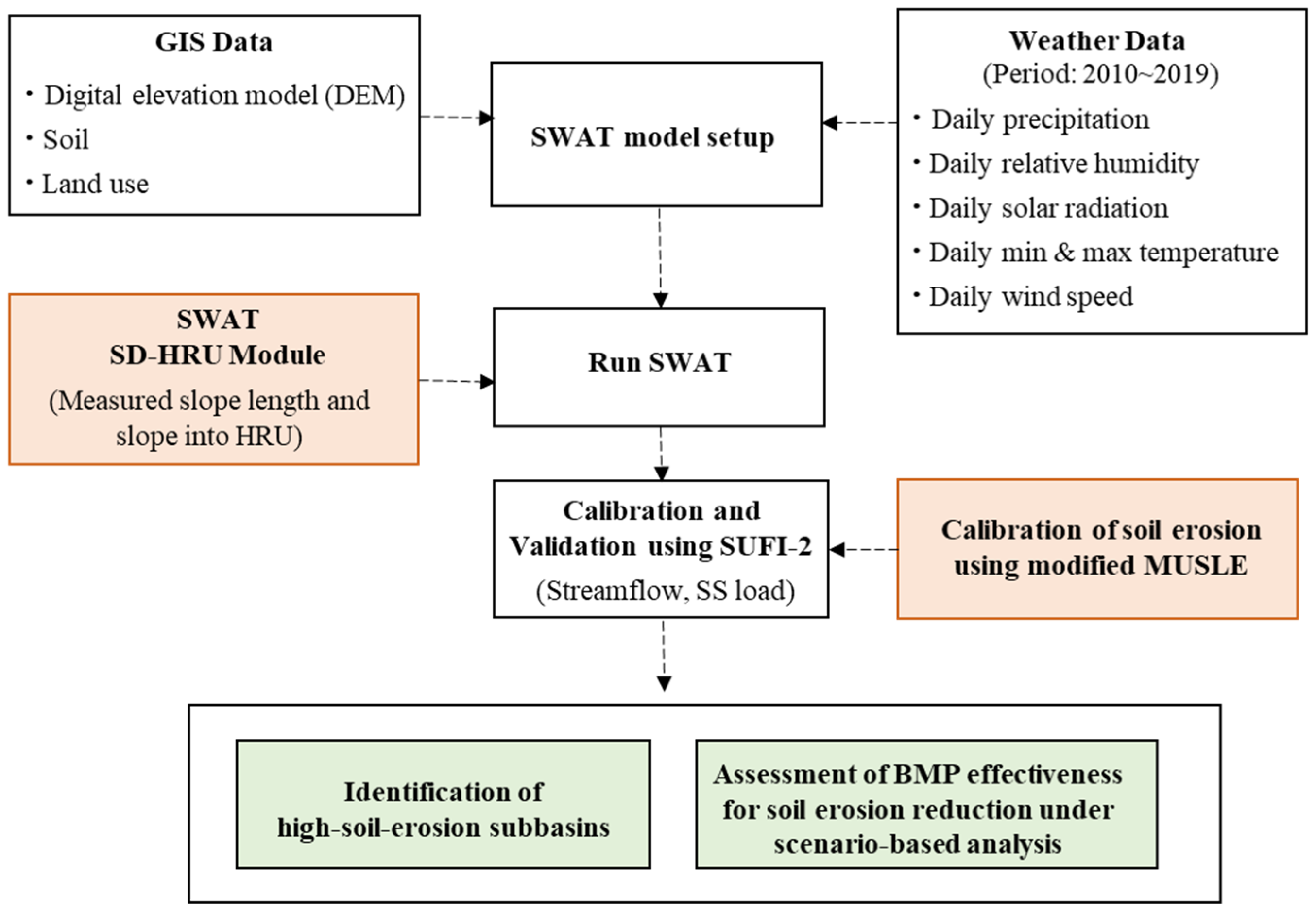
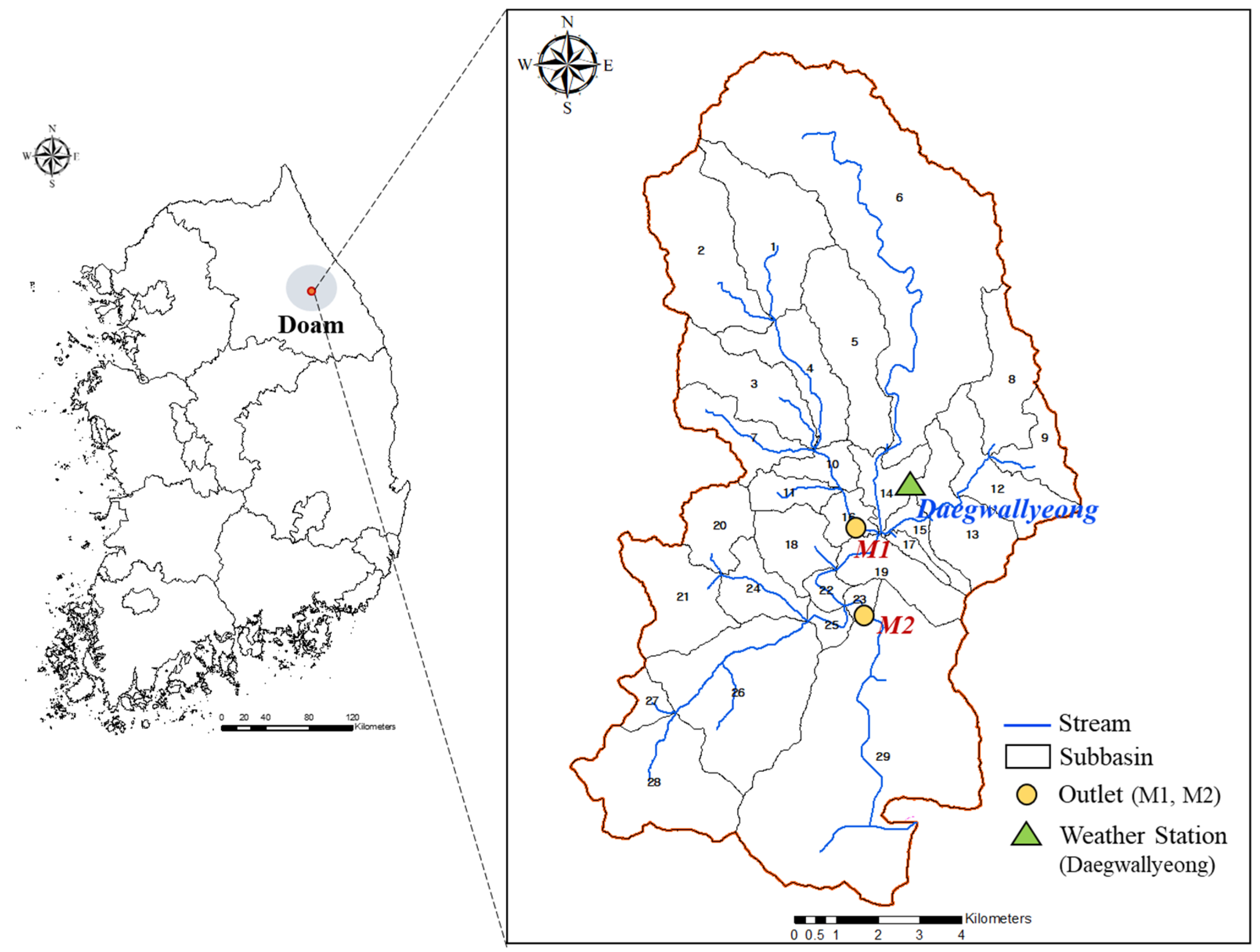
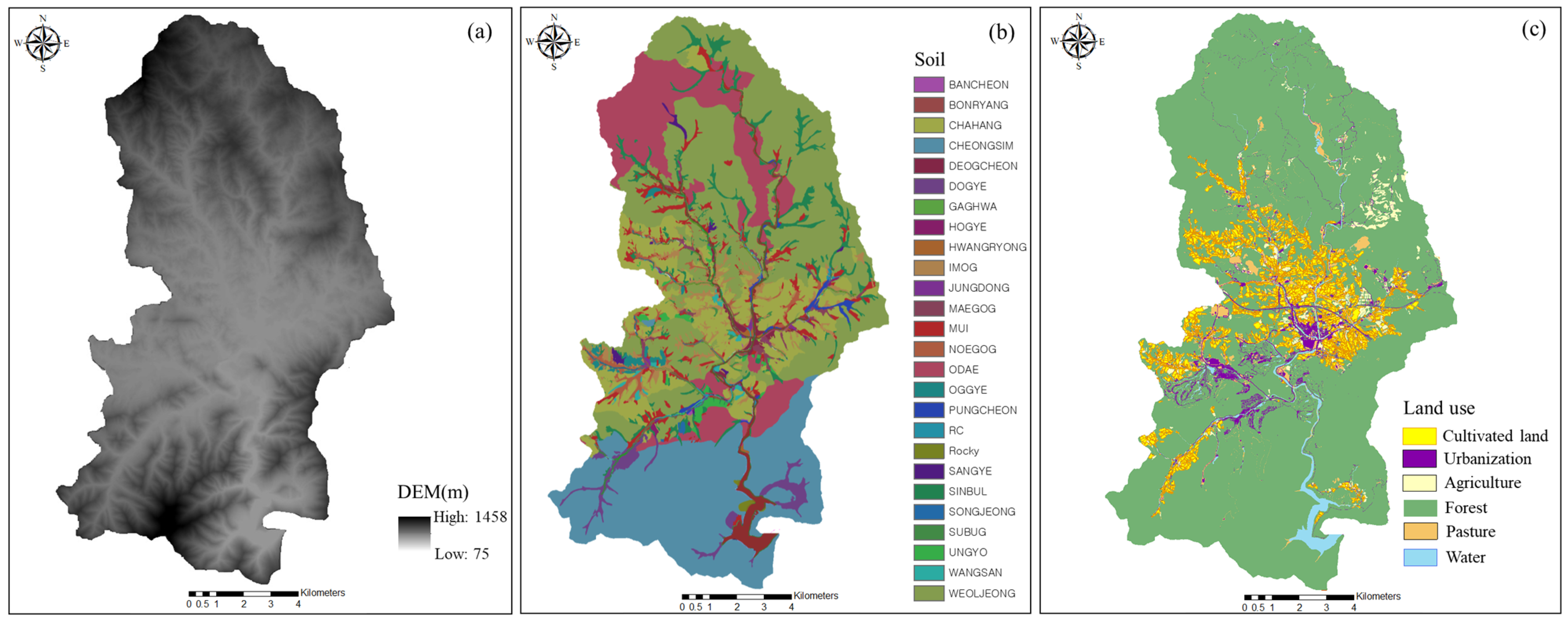
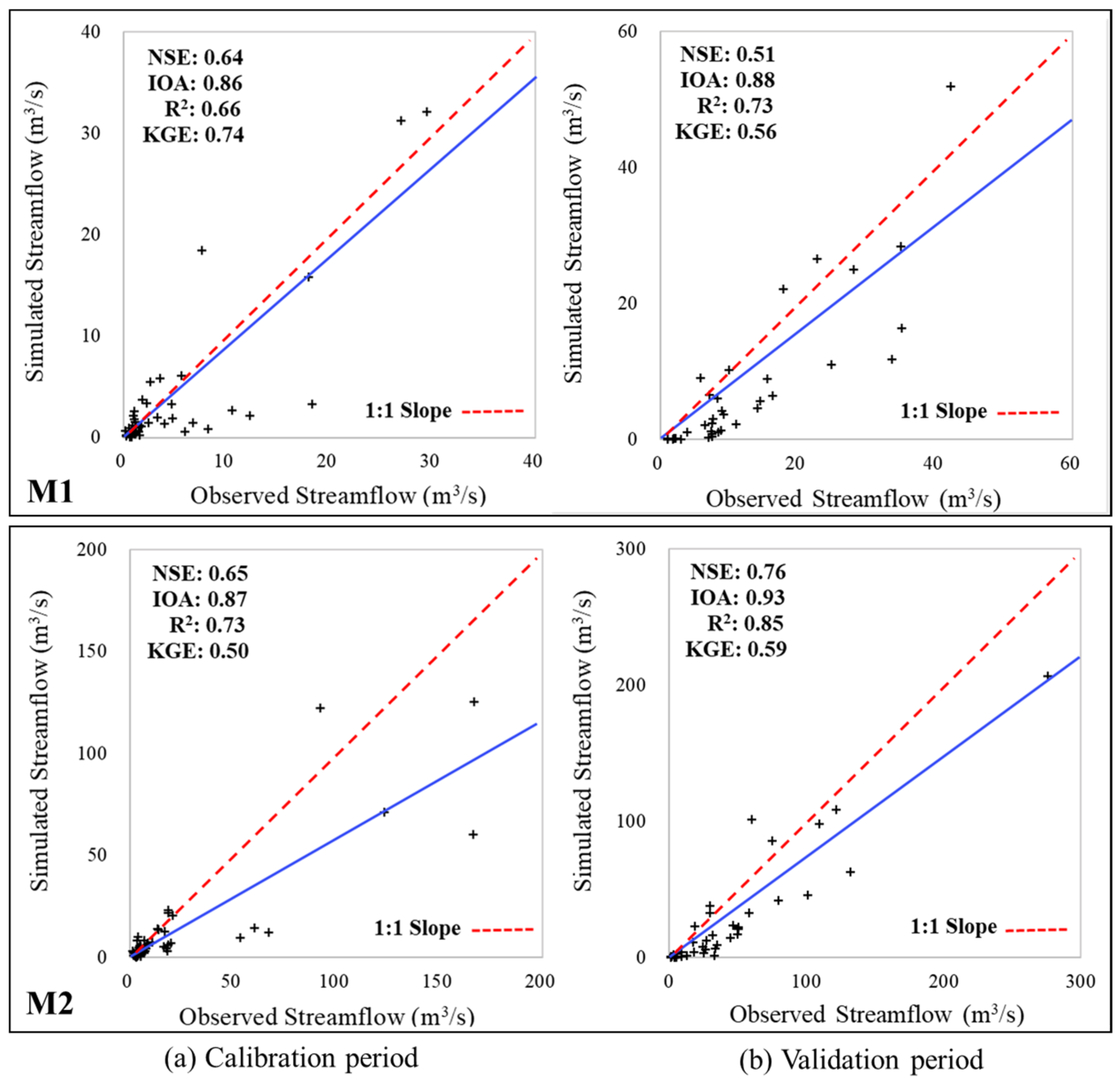
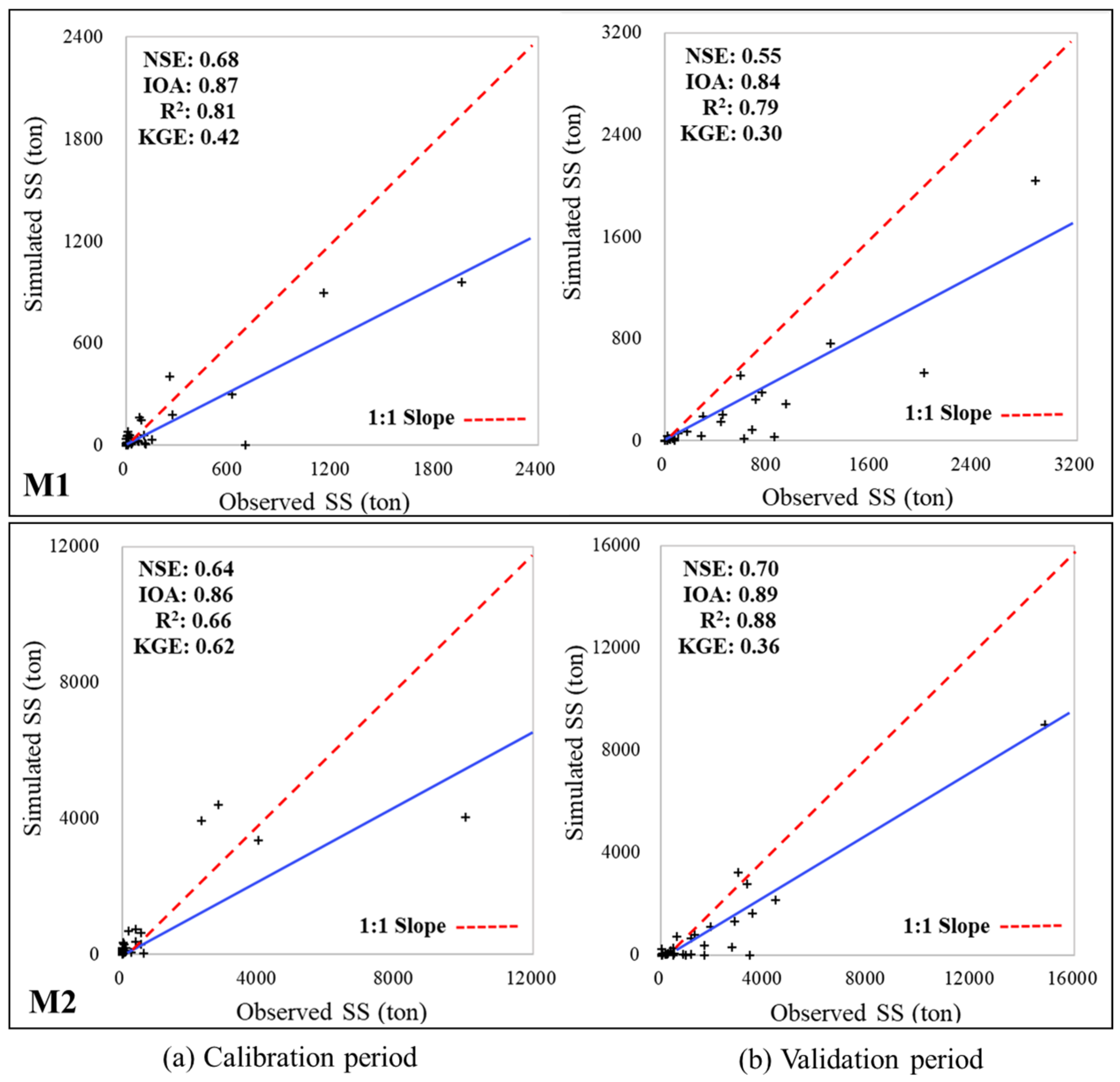
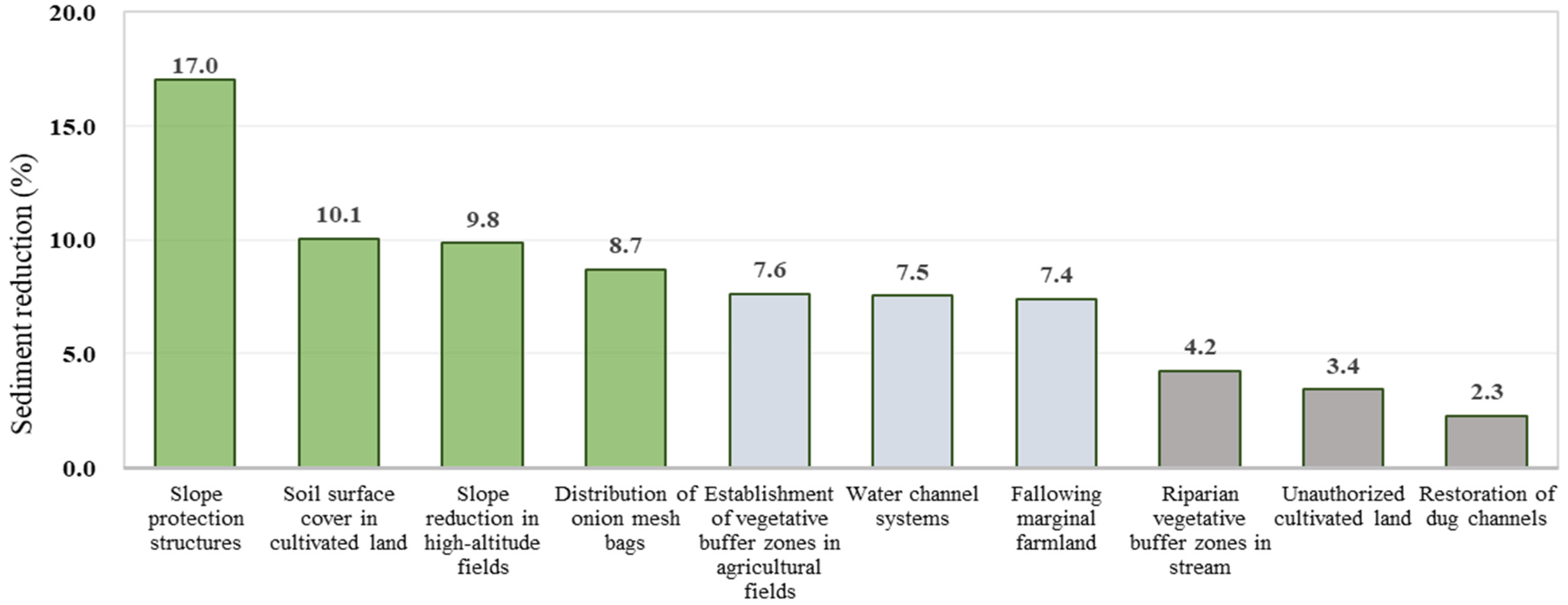
| Years | Average Precipitation (mm) | Seasonal (mm) | |||
|---|---|---|---|---|---|
| Spring | Summer | Fall | Winter | ||
| 2010 | 1217.5 | 307.2 | 385.6 | 397.1 | 127.6 |
| 2011 | 1762.1 | 304.5 | 982.5 | 330.0 | 145.1 |
| 2012 | 1289.2 | 271.7 | 699.5 | 223.4 | 94.6 |
| 2013 | 1052.8 | 185.2 | 527.4 | 221.7 | 118.5 |
| 2014 | 1309.6 | 216.0 | 586.1 | 362.7 | 144.8 |
| 2015 | 982.2 | 97.2 | 532.0 | 296.2 | 56.8 |
| 2016 | 1183.9 | 149.7 | 746.0 | 193.6 | 94.6 |
| 2017 | 1025.3 | 110.5 | 721.7 | 155.0 | 38.1 |
| 2018 | 1731.0 | 404.6 | 854.1 | 403.8 | 68.5 |
| 2019 | 1199.0 | 114.0 | 558.1 | 507.3 | 19.6 |
| Average | 1275.3 | 216.1 | 659.3 | 309.1 | 90.8 |
| NO. | Description | Scenario 1 | Scenario 2 |
|---|---|---|---|
| 1 | Following marginal farmland | O | |
| 2 | Slope reduction in high-altitude fields | O | |
| 3 | Establishment of vegetative buffer zones in agricultural fields | O | |
| 4 | Riparian vegetative buffer zones in stream | O | |
| 5 | Slope protection structures (installation of NPRFs) | O | O |
| 6 | Water channel systems (installation of NPRFs) | O | O |
| 7 | Soil surface cover in cultivated land | O | O |
| 8 | Distribution of onion mesh bags | O | O |
| 9 | Restoration of dug channels | O | O |
| 10 | Unauthorized cultivated land | O | O |
| Land Use | MUSLE Runoff Factor | |||
|---|---|---|---|---|
| Existing MUSLE | Modified MUSLE | |||
| Coefficient | Exponent | Coefficient | Exponent | |
| Agricultural | 11.80 | 0.56 | 2.80 | 0.54 |
| Forest | 11.80 | 0.56 | 0.38 | 0.55 |
| Parameters | Definition | Ranges | Optimal Value |
|---|---|---|---|
| CN2 | SCS runoff curve number | 0.8–1.2 | 1.2 |
| GWQMN | Threshold depth of water in the shallow aquifer required for return flow to occur | 0–5000 | 100 |
| SOL_AWC | Available water capacity of the soil layer | 0.8–1.2 | 1.2 |
| ALPHA_BF | Baseflow alpha factor | 0.0–1.0 | 0.183 |
| REVAPMN | Threshold depth of water in the shallow aquifer for “revap” to occur | 0–500 | 200 |
| SOL_K | Saturated hydraulic conductivity (mm/h) | 0.8–1.2 | 1.2 |
| SPEXP | Exponent parameter for calculating sediment entrained in channel sediment routing | 1.0–2.0 | 1.5 |
| CH_COV2 | Channel cover factor | −0.001–1.0 | 1.0 |
| ADJ_PKR | Peak rate adjustment factor for sediment routing in the subbasin (tributary channels) | 0.5–2.0 | 1.4 |
| Section | Baseline | Scenario 1 | Scenario 2 |
|---|---|---|---|
| Soil erosion | 2913 (tons/ha/year) | 1904 (34.6%) | 1185 (59.3%) |
| SS concentration | 32.3 (mg/L) | 21.0 (35.0%) | 13.8 (57.3%) |
| Subbasin | Baseline | Scenario 1 | Scenario 2 | ||||
|---|---|---|---|---|---|---|---|
| Soil Erosion (ton/yr) | Reduction Efficiency (%) | Prioritization Rank | Soil Erosion (ton/yr) | Reduction Efficiency (%) | Prioritization Rank | ||
| 1 | 504 | 408 | 19.1% | 14 | 373 | 26.0% | 18 |
| 2 | 981 | 741 | 24.5% | 13 | 576 | 41.3% | 14 |
| 3 | 683 | 425 | 37.8% | 8 | 360 | 47.3% | 11 |
| 4 | 2052 | 1182 | 42.4% | 7 | 656 | 68.0% | 4 |
| 5 | 3166 | 1396 | 55.9% | 2 | 978 | 69.1% | 2 |
| 6 | 6038 | 5034 | 16.6% | 15 | 4852 | 19.6% | 22 |
| 7 | 363 | 240 | 33.9% | 9 | 197 | 45.7% | 12 |
| 8 | 177 | 149 | 15.8% | 16 | 102 | 42.4% | 13 |
| 9 | 269 | 245 | 8.9% | 21 | 216 | 19.7% | 21 |
| 10 | 893 | 787 | 11.9% | 19 | 426 | 52.3% | 9 |
| 11 | 225 | 116 | 48.4% | 4 | 90 | 60.0% | 6 |
| 12 | 184 | 125 | 32.1% | 11 | 123 | 33.2% | 17 |
| 13 | 462 | 441 | 4.6% | 24 | 370 | 19.9% | 20 |
| 14 | 569 | 518 | 9.0% | 20 | 257 | 54.8% | 8 |
| 15 | 21 | 18 | 14.3% | 18 | 18 | 14.3% | 24 |
| 16 | 58 | 49 | 15.5% | 17 | 49 | 15.5% | 23 |
| 17 | 82 | 81 | 1.2% | 28 | 53 | 35.4% | 16 |
| 18 | 626 | 420 | 32.9% | 10 | 381 | 39.1% | 15 |
| 19 | 233 | 224 | 3.9% | 25 | 179 | 23.2% | 19 |
| 20 | 1906 | 1045 | 45.2% | 6 | 749 | 60.7% | 5 |
| 21 | 2015 | 973 | 51.7% | 3 | 877 | 56.5% | 7 |
| 22 | 40 | 38 | 5.0% | 23 | 35 | 12.5% | 25 |
| 23 | 14 | 14 | 1.4% | 26 | 14 | 1.4% | 28 |
| 24 | 236 | 220 | 6.8% | 22 | 212 | 10.2% | 26 |
| 25 | 15 | 15 | 1.3% | 27 | 15 | 1.3% | 29 |
| 26 | 1221 | 909 | 25.6% | 12 | 388 | 68.2% | 3 |
| 27 | 638 | 225 | 64.7% | 1 | 188 | 70.5% | 1 |
| 28 | 75 | 40 | 46.7% | 5 | 36 | 52.0% | 10 |
| 29 | 236 | 235 | 0.4% | 29 | 217 | 8.1% | 27 |
Disclaimer/Publisher’s Note: The statements, opinions and data contained in all publications are solely those of the individual author(s) and contributor(s) and not of MDPI and/or the editor(s). MDPI and/or the editor(s) disclaim responsibility for any injury to people or property resulting from any ideas, methods, instructions or products referred to in the content. |
© 2025 by the authors. Licensee MDPI, Basel, Switzerland. This article is an open access article distributed under the terms and conditions of the Creative Commons Attribution (CC BY) license (https://creativecommons.org/licenses/by/4.0/).
Share and Cite
Lee, J.; Lee, S.; Park, W.J.; Shin, M.; Lim, K.J. Assessment of Integrated BMPs for Subbasin-Scale Soil Erosion Reduction Considering Spatially Distributed Farmland Characteristics. Agriculture 2025, 15, 893. https://doi.org/10.3390/agriculture15080893
Lee J, Lee S, Park WJ, Shin M, Lim KJ. Assessment of Integrated BMPs for Subbasin-Scale Soil Erosion Reduction Considering Spatially Distributed Farmland Characteristics. Agriculture. 2025; 15(8):893. https://doi.org/10.3390/agriculture15080893
Chicago/Turabian StyleLee, Jimin, Seoro Lee, Woon Ji Park, Minhwan Shin, and Kyoung Jae Lim. 2025. "Assessment of Integrated BMPs for Subbasin-Scale Soil Erosion Reduction Considering Spatially Distributed Farmland Characteristics" Agriculture 15, no. 8: 893. https://doi.org/10.3390/agriculture15080893
APA StyleLee, J., Lee, S., Park, W. J., Shin, M., & Lim, K. J. (2025). Assessment of Integrated BMPs for Subbasin-Scale Soil Erosion Reduction Considering Spatially Distributed Farmland Characteristics. Agriculture, 15(8), 893. https://doi.org/10.3390/agriculture15080893








